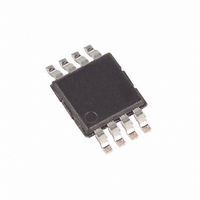DS1825U+ Maxim Integrated Products, DS1825U+ Datasheet - Page 6

DS1825U+
Manufacturer Part Number
DS1825U+
Description
IC THERMOMETER DIGITAL 8-USOP
Manufacturer
Maxim Integrated Products
Datasheet
1.DS1825U.pdf
(21 pages)
Specifications of DS1825U+
Function
Thermometer, Thermostat
Topology
Register Bank, Scratchpad
Sensor Type
Internal
Sensing Temperature
-55°C ~ 125°C
Output Type
Digital
Output Alarm
Yes
Output Fan
No
Voltage - Supply
3 V ~ 3.7 V
Operating Temperature
-55°C ~ 125°C
Mounting Type
Surface Mount
Package / Case
8-MSOP, Micro8™, 8-uMAX, 8-uSOP,
Temperature Threshold
Programmable
Full Temp Accuracy
+/- 0.5 C
Digital Output - Bus Interface
1-Wire
Digital Output - Number Of Bits
9 bit to 12 bit
Supply Voltage (max)
3.7 V
Supply Voltage (min)
3 V
Maximum Operating Temperature
+ 125 C
Minimum Operating Temperature
- 55 C
Supply Current
1.5 mA
Ic Output Type
Digital
Sensing Accuracy Range
± 0.5°C
Supply Voltage Range
3V To 3.7V
Resolution (bits)
12bit
Sensor Case Style
µSOP
No. Of Pins
8
Accuracy %
0.5°C
Rohs Compliant
Yes
Lead Free Status / RoHS Status
Lead free / RoHS Compliant
DS1825 Programmable Resolution 1-Wire Digital Thermometer With 4-Bit ID
Figure 3. T
AND T
REGISTER FORMAT
H
L
bit 7
bit 6
bit 5
bit 4
bit 3
bit 2
bit 1
bit 0
6
5
5
5
2
1
0
S
2
2
2
2
2
2
2
Only bits 11 through 4 of the temperature register are used in the T
and T
comparison since T
and T
are 8-bit
H
L
H
L
registers. If the measured temperature is lower than or equal to T
or higher than or equal to T
, an alarm condition
L
H
exists and an alarm flag is set inside the DS1825. This flag is updated after every temperature measurement;
therefore, if the alarm condition goes away, the flag will be turned off after the next temperature conversion.
The master device can check the alarm flag status of all DS1825s on the bus by issuing an Alarm Search [ECh]
command. Any DS1825s with a set alarm flag will respond to the command, so the master can determine exactly
which DS1825s have experienced an alarm condition. If an alarm condition exists and the T
or T
settings have
H
L
changed, another temperature conversion should be done to validate the alarm condition.
POWERING THE DS1825
The DS1825 can be powered by an external supply on the V
pin, or it can operate in “parasite power” mode,
DD
which allows the DS1825 to function without a local external supply. Parasite power is very useful for applications
that require remote temperature sensing or that are very space constrained. Figure 1 shows the DS1825’s
parasite-power control circuitry, which “steals” power from the 1-Wire bus through the DQ pin when the bus is high.
The stolen charge powers the DS1825 while the bus is high, and some of the charge is stored on the parasite
power capacitor (C
) to provide power when the bus is low. When the DS1825 is used in parasite power mode,
PP
the V
pin must be connected to ground.
DD
In parasite power mode, the 1-Wire bus and C
can provide sufficient current to the DS1825 for most operations
PP
as long as the specified timing and voltage requirements are met (refer to the DC ELECTRICAL
CHARACTERISTICS and the AC ELECTRICAL CHARACTERISTICS sections of this data sheet). However, when
the DS1825 is performing temperature conversions or copying data from the scratchpad memory to EEPROM, the
operating current can be as high as 1.5mA. This current can cause an unacceptable voltage drop across the weak
1-Wire pullup resistor and is more current than can be supplied by C
. To assure that the DS1825 has sufficient
PP
supply current, it is necessary to provide a strong pullup on the 1-Wire bus whenever temperature conversions are
taking place or data is being copied from the scratchpad to EEPROM. This can be accomplished by using a
MOSFET to pull the bus directly to the rail as shown in Figure 4. The 1-Wire bus must be switched to the strong
pullup within 10ms (max) after a Convert T [44h] or Copy Scratchpad [48h] command is issued, and the bus must
be held high by the pullup for the duration of the conversion (t
) or data transfer (t
= 10ms). No other activity can
conv
wr
take place on the 1-Wire bus while the pullup is enabled.
The DS1825 can also be powered by the conventional method of connecting an external power supply to the V
DD
pin, as shown in Figure 5. The advantage of this method is that the MOSFET pullup is not required, and the 1-Wire
bus is free to carry other traffic during the temperature conversion time.
The use of parasite power is not recommended for temperatures above 100°C since the DS1825 may not be able
to sustain communications due to the higher leakage currents that can exist at these temperatures. For
applications in which such temperatures are likely, it is strongly recommended that the DS1825 be powered by an
external power supply.
In some situations the bus master may not know whether the DS1825s on the bus are parasite powered or
powered by external supplies. The master needs this information to determine if the strong bus pullup should be
used during temperature conversions. To get this information, the master can issue a Skip ROM [CCh] command
followed by a Read Power Supply [B4h] command followed by a “read time slot”. During the read time slot, parasite
powered DS1825s will pull the bus low, and externally powered DS1825s will let the bus remain high. If the bus is
pulled low, the master knows that it must supply the strong pullup on the 1-Wire bus during temperature
conversions.
6 of 21











